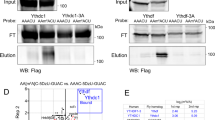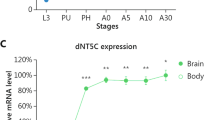Abstract
We found that several transposable elements were highly active in Drosophila brain during normal aging. In addition, we found that mutations in Drosophila Argonaute 2 (Ago2) resulted in exacerbated transposon expression in the brain, progressive and age-dependent memory impairment, and shortened lifespan. These findings suggest that transposon activation may contribute to age-dependent loss of neuronal function.
This is a preview of subscription content, access via your institution
Access options
Subscribe to this journal
Receive 12 print issues and online access
$209.00 per year
only $17.42 per issue
Buy this article
- Purchase on SpringerLink
- Instant access to full article PDF
Prices may be subject to local taxes which are calculated during checkout



Similar content being viewed by others
References
Belancio, V.P., Hedges, D.J. & Deininger, P. Genome Res. 18, 343–358 (2008).
Goodier, J.L. & Kazazian, H.H. Jr. Cell 135, 23–35 (2008).
Muotri, A.R. et al. Nature 435, 903–910 (2005).
Coufal, N.G. et al. Nature 460, 1127–1131 (2009).
Baillie, J.K. et al. Nature 479, 534–537 (2011).
Lathe, R. & Harris, A. J. Mol. Biol. 392, 813–822 (2009).
Muotri, A.R. et al. Nature 468, 443–446 (2010).
Jeong, B.H., Lee, Y.J., Carp, R.I. & Kim, Y.S. J. Clin. Virol. 47, 136–142 (2010).
Coufal, N.G. et al. Proc. Natl. Acad. Sci. USA 108, 20382–20387 (2011).
Douville, R., Liu, J., Rothstein, J. & Nath, A. Ann. Neurol. 69, 141–151 (2011).
Kaneko, H. et al. Nature 471, 325–330 (2011).
Tan, H. et al. Hum. Mol. Genet. 21, 57–65 (2012).
Li, W., Jin, Y., Prazak, L., Hammell, M. & Dubnau, J. PLoS ONE 7, e44099 (2012).
Czech, B. & Hannon, G.J. Nat. Rev. Genet. 12, 19–31 (2011).
Labrador, M., Sha, K., Li, A. & Corces, V.G. Genetics 180, 1367–1378 (2008).
Schwaerzel, M., Heisenberg, M. & Zars, T. Neuron 35, 951–960 (2002).
Dubnau, J. & Chiang, A.S. Curr. Opin. Neurobiol. 23, 84–91 (2013).
Lim, D.H. et al. FEBS Lett. 585, 3079–3085 (2011).
Liu, N. et al. Nature 482, 519–523 (2012).
Chen, Y., Pane, A. & Schupbach, T. Curr. Biol. 17, 637–642 (2007).
Tully, T., Preat, T., Boynton, S.C. & Del Vecchio, M. Cell 79, 35–47 (1994).
Qin, H. et al. Curr. Biol. 22, 608–614 (2012).
Chen, G. et al. PLoS Comput. Biol. 4, e1000026 (2008).
Song, S.U., Gerasimova, T., Kurkulos, M., Boeke, J.D. & Corces, V.G. Genes Dev. 8, 2046–2057 (1994).
Acknowledgements
We thank B. Czech and G. Hannon (Cold Spring Harbor Laboratory) for the Ago2414 and loki RNAi fly lines, F.-B. Gao (University of Massachusetts Medical School) for the Ago251B fly line, B. Dickson (Institute of Molecular Pathology) for the UAS∷Ago2 transgenic fly line, M. Welte (University of Rochester) for the Ago2454 fly line, T. Lee (Janelia Farm Research Campus) for the pTub-GAL80 in Casper4 plasmid, J. Boek (Johns Hopkins University School of Medicine) for the 7B3 hybridoma cell line, and C. Bautista at the Cold Spring Harbor Laboratory shared resources for ascites production. We thank T. Russel for technical assistance in construction of the gypsy reporter system. We also are grateful to S. Waddell, J. Beshel, M. Cressy, B. Czech, G. Hannon, K. Honegger, J. Huang, M. Kernan, R. Martienssen, H. Qin, C. Sandoval, Y. Shuai, G. Turner, T. Zador and Y. Zhong for helpful discussions or comments on the manuscript. This work was supported by US National Institutes of Health grant TR01(5R01NS067690-03) and DART NeuroScience LLC awarded to J.D. S.G. received additional support from the Shakespeare Fellowship and the Ernst Göhner Foundation.
Author information
Authors and Affiliations
Contributions
W.L., L.P. and J.D. conceived and designed the project and analyzed the experiments. W.L. performed the behavior experiments and western blots. The QPCR and lifespan analyses were performed by L.P. with assistance from W.L., L.K. and D.T. L.P., N.C. and S.G. did the imaging. W.L., L.P. and J.D. wrote the manuscript with comments from the other authors.
Corresponding author
Ethics declarations
Competing interests
This work was funded in part by DART NeuroScience LLC via a research grant to J.D.
Supplementary information
Supplementary Text and Figures
Supplementary Figures 1–7 and Supplementary Tables 1 and 2 (PDF 9582 kb)
Rights and permissions
About this article
Cite this article
Li, W., Prazak, L., Chatterjee, N. et al. Activation of transposable elements during aging and neuronal decline in Drosophila. Nat Neurosci 16, 529–531 (2013). https://doi.org/10.1038/nn.3368
Received:
Accepted:
Published:
Issue Date:
DOI: https://doi.org/10.1038/nn.3368
This article is cited by
-
Regulation of insect behavior by non-coding RNAs
Science China Life Sciences (2024)
-
Endogenous retroviruses and TDP-43 proteinopathy form a sustaining feedback driving intercellular spread of Drosophila neurodegeneration
Nature Communications (2023)
-
Downregulation of transposable elements extends lifespan in Caenorhabditis elegans
Nature Communications (2023)
-
Resveratrol blocks retrotransposition of LINE-1 through PPAR α and sirtuin-6
Scientific Reports (2022)
-
Molecular mechanisms of exceptional lifespan increase of Drosophila melanogaster with different genotypes after combinations of pro-longevity interventions
Communications Biology (2022)



